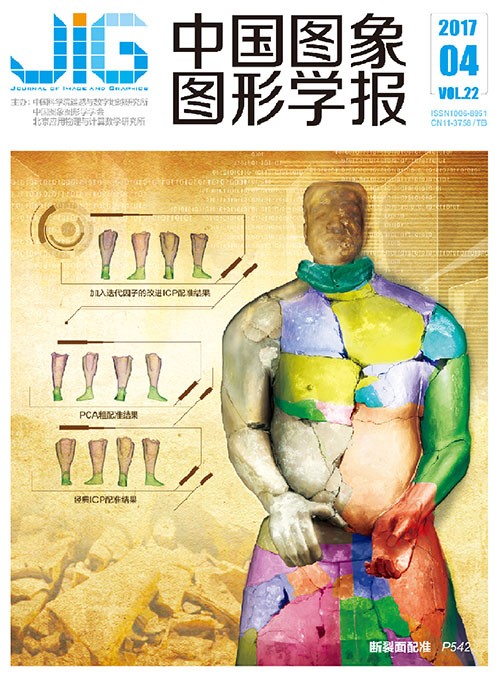
前列腺磁共振图像分割的反卷积神经网络方法
摘 要
目的 前列腺磁共振图像存在组织边界对比度低、有效区域少等问题,手工勾勒组织轮廓边界的传统分割方法无法满足临床实时性要求,针对这些问题提出了一种基于深度反卷积神经网络的前列腺磁共振图像分割算法。方法 基于深度学习理论,将训练图像样本输入设计好的卷积神经网络,提取具有高度区分性的前列腺图像特征,反卷积策略用于拓展特征图尺寸,使网络的输入尺寸与输出预测图大小匹配。网络生成的概率预测图通过训练一个softmax分类器,对预测图像取二值化,获得最终的分割结果。为克服原始图像中有效组织较少的问题,采用dice相似性系数作为卷积网络的损失函数。结果 本文算法以Dice相似性系数和Hausdorff距离作为评价指标,在MICCAI 2012数据集中,Dice相似性系数大于89.75%,Hausdorff距离小于1.3 mm,达到了传统方法的分割精度,并且将处理时间缩短在1 min以内,明显优于其他方法。结论 定量与定性的实验表明,基于反卷积神经网络的前列腺分割方法可以准确地对磁共振图像进行分割,相比于其他分割算法大幅度减小了处理时间,能够很好地适用于临床的前列腺图像分割任务。
关键词
Deconvolutional neural network for prostate MRI segmentation
Zhan Shu1, Liang Zhicheng1, Xie Dongdong2(1.School of Computer and Information, Hefei University of Technology, Hefei 230009, China;2.Department of Urology, the Second Affiliated Hospital of Anhui Medical University, Hefei 230601, China) Abstract
Objective Prostate cancer is one of the leading causes of deaths due to cancer among older men, and its diagnosis experiences many challenging problems. Imaging-based prostate cancer screening, such as magnetic resonance imaging (MRI), requires an experienced medical professional to extensively review the obtained data and perform a diagnosis. The first step in prostate radiation therapy is to identify the difference between the original image and the nearby prostate tissue. However, prostate MRI results face the problems of low organizational boundary contrast ratio and lack of effective areas. Manual segmentation will take considerable time, which cannot meet clinical real-time requirements. Although several methods presented in the MICCAI 2012 challenge achieved reasonable results, they highly depended on feature selection or statistical shape modeling performance, and thus, presented limited success. A segmentation algorithm for prostate MRI based on a deep deconvolutional neural network is proposed to solve the aforementioned deficiencies. Method Inspired by the latest deep learning technology, fully convolutional network, and DeconvNet, we present a multi-layer deconvolutional convolutional network to demonstrate that a deep neural network can dramatically increase the automated segmentation of prostate MRI images compared with systems based on handcrafted features. The deep neural network model exhibits strong feature learning and end-to-end training capacities, which provide better performance than former image processing techniques. Unlike an image classification task, each pixel in an MRI image is regarded as an object that should be classified. Hence, we obtain the final segmentation results by considering the prediction of prostate tissues as a two-stage classification task. This study presents a multi-layer convolutional network, which utilizes a convolution filter, a pooling layer, and a decoder network to transform an input MRI image into a probability map. A convolutional neural network is used in the training process of this model to extract highly distinct image features. Then, a deconvolution strategy is adopted to expand the feature map size and to maintain the sizes of the input image and the output probability map. The stacked convolution and deconvolution layers can maintain resolution size by adding a pad to the input image. In addition to achieving deeper network architecture, the stacked convolution layers exhibit strong robustness against overfitting. Finally, the probability map is used to train a softmax classifier and the final segmentation result is obtained. We replace the classical neuron activation function with a rectified linear unit in our model to speed up the training process and avoid the vanishing gradient. The Dice similarity coefficient is used as the loss function in our convolutional network to overcome the problem of low effective organization in the original image. The images provided in MICCAI 2012 exhibit varying sizes and resolutions, and thus, we preprocess the images and augment the size of the data set via multi-scale cropping and scale transformation to improve training reliability. Result All the experiments are performed on the MICCAI 2012 data set. The algorithm proposed in this study uses the Dice similarity coefficient and Hausdorff distance as evaluation metrics. The Dice similarity coefficient is over 89.75%, whereas Hausdorff distance is shorter than 1.3 mm, which can realize the segmentation accuracy of traditional methods. Furthermore, the processing time is shortened to within 1 min, which is clearly superior to those of other methods. Conclusion The deep learning approach is gradually being applied to the medical field. This study introduces a new deep learning method that is used to segment prostate images. Both the qualitative and quantitative experiments show that the prostate segmenting method based on the deconvolutional neural network can segment MRI images accurately. The proposed method can attain higher segmentation accuracy than the traditional methods. All the calculations are performed on a graphics processing unit, and handling time is considerably shortened compared with those of other segmentation algorithms. Therefore, the proposed model is highly appropriate for the clinical segmentation of prostate images.
Keywords
prostate segmentation magnetic resonance imaging convolutional neural network Dice similarity coefficient Hausdorff distance
|



 中国图象图形学报 │ 京ICP备05080539号-4 │ 本系统由
中国图象图形学报 │ 京ICP备05080539号-4 │ 本系统由